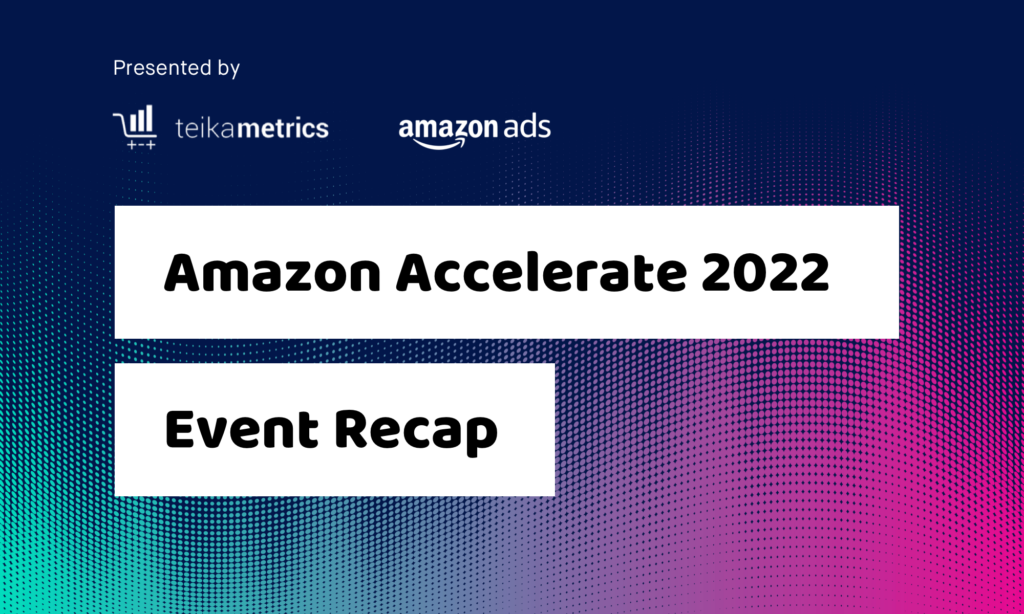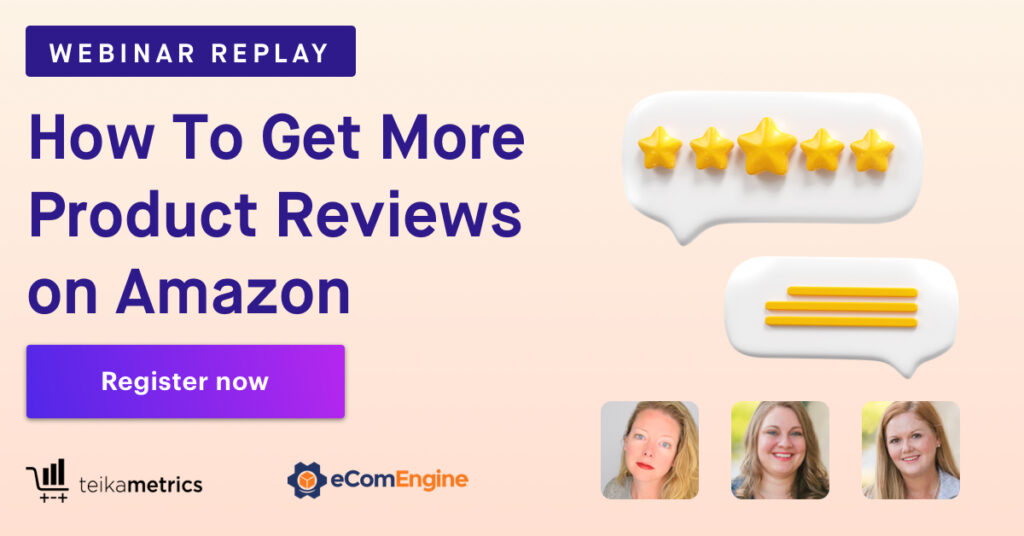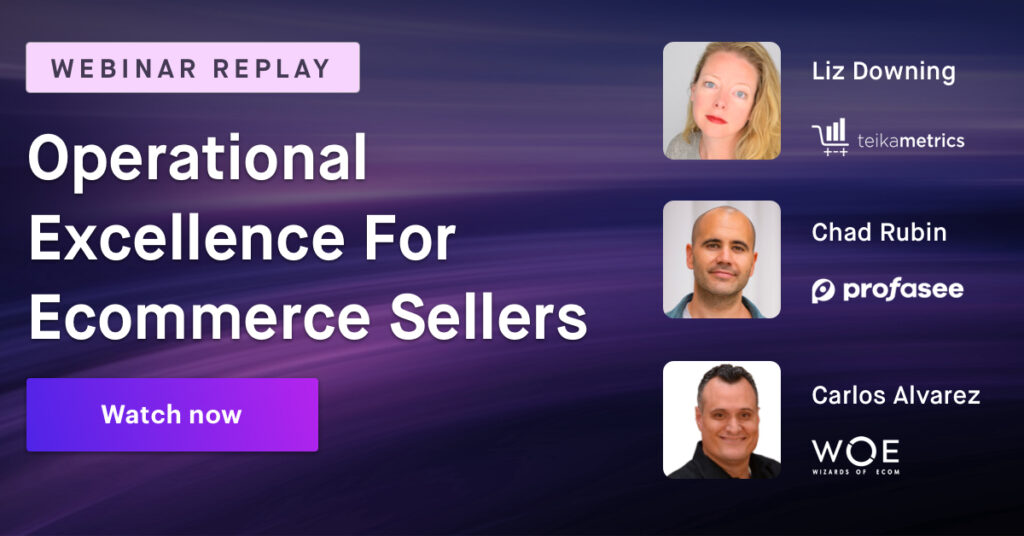What was Amazon Accelerate?
Amazon Accelerate was Amazon’s annual in-person event, offering sellers of ALL sizes the opportunity to gather in person to network, learn the latest strategies and insights from Amazon directly, share strategies with one another, and hear about new feature announcements.
In this brief recap, we’ll summarize everything you need to know from Amazon Accelerate:
- Announcements
- Education & Strategy
- The general pulse of the e-commerce community
It’s all here, so whether you were there or missed out, this recap will give everything you need to know.

What was announced at Amazon Accelerate?
By far the biggest focus of Amazon Accelerate were announcements for seller features and updates. We’ll summarize the biggest announcements from the event, and then break down each one in more detail:
Summary:
- Express Payouts: US Sellers can now receive payouts within 24 hours instead of 3-5 days
- Escalate Case: New ability to escalate seller support cases and expanded access to chat, phone & email support for sellers.
- Amazon Alexa: Alexa will now suggest products when asked a question; Entirely new way to access customers
- Buy With Prime: Integrate Amazon purchasing and fulfillment directly on your own website; New ways to own Amazon customer data & draw customers to your own ecommerce site.
- Premium A+ Content: Image carousels, rich format charts, and entirely new listing content are now available for brand owners.
- Tailored Audiences: New ways to contact Amazon customers directly through custom HTML emails; Contact repeat customers, recent customers, and high-spending customers.
- Amazon Warehousing & Distribution: Easily store & manage bulk inventory; Amazon’s centralized solution to increasing storage & fulfillment fees
- Local Selling: New ways to geo-target local areas, offer curbside pickup, and list pickup-only items on Amazon.
- Amazon International: Automated pricing management across international marketplaces and in-house solutions to currency conversions and transfers.
Amazon Alexa
Buyers have already been able to order products on Amazon vocally through Alexa, but Amazon is taking Alexa ordering to the next level.
Now, when buyers ask Alexa questions like, “Alexa, how can I remove pet hair from my carpet?”, Alexa will give an answer while also recommending specific products. The goal here is to tie seller questions back to specific products – this is a huge way to leverage voice in an entirely new way.
Starting small in October and expanding in 2023, shopping through Alexa has incredible implications for unlocking new growth mediums for sellers.
Buy with Prime
What is it?
Buy with Prime was one of Amazon’s biggest announcements at Accelerate.
Buy with Prime unlocks the ability for sellers to easily integrate Prime shipping and purchasing on their own brand’s direct-to-consumer (DTC) website, primarily offering sellers the ability to integrate seamless Prime checkouts and Prime Shipping.
In short, it primarily acts as a custom button sellers can add on their own site for quick checkout and fulfillment in addition to bringing more shoppers over to your own site from Amazon.
What was announced?
While Buy with Prime isn’t necessarily an entirely new program (it was soft-launched around 5 months ago and kept under wraps), there were a number of announcements given at Accelerate with huge implications for sellers.
- A new Buy with Prime page within your Brand’s Store
- New ways to drive traffic from Amazon directly to your website
- New ways to harvest Amazon customer data
- Direct purchase & ad integration with Facebook and Instagram
All of this leads to more traffic on your own ecommerce site, more control over customer data, more ways to tap into traffic from Amazon, and more conversions on & off Amazon. Buy with Prime is currently invite-only,
Premium A+ Content
Amazon announced that Premium A+ Content is now available to brand owners, opening the door for brand-registered sellers to take advantage of new content in listings to increase conversions and sales.
According to Amazon, brands that create A+ content see an “8% lift in sales”. The success of A+ content lead Amazon to develop Premium A+ Content, including interactive hotspots, image carousels and rich format charts in product listings.
With limited tests and availability, Amazon said Premium A+ Content increased sales by up to 20%. Sellers should look forward to new ways to further build out product listings.
Tailored Audiences
Through a new program called Tailored Audiences, Amazon announced new ways to reach out to existing customers.
In addition to brand followers, sellers are now able to contact repeat customers, recent customers, and high-spending customers via email.
Through Tailored Audiences, Amazon is giving sellers even more ways to contact and remarked to sellers directly through email, including HTML customization to improve engagement and conversion.
You’ll be able to contact those three categories of customers directly about new deals or promotions in addition to new product launches.
Amazon Warehousing & Distribution
According to Amazon, 34% of sellers identified high prices and complicated fee structures as their biggest pain points when it comes to supply chains, warehousing & distribution.
Amazon Warehousing & Distribution (AWD) was created to help sellers solve their biggest inventory-related pain points.
AWD allows sellers to send and store bulk inventory, integrating directly with the Amazon Fulfillment Network and offering a pay-as-you-go pricing model.
AWD allows sellers to send inventory to any distribution channel (including wholesalers, regional distributors, brick and mortar stores, etc.).
AWD essentially helps sellers store more products within Amazon’s own warehouse system, integrating directly with Amazon Fulfillment, making storage and fulfillment a whole lot easier and better-integrated compared to tapping into external 3PL solutions.
The Local Selling Program
Amazon is investing heavily in local shopping & delivery, announcing new ways for sellers to list and fulfill products, geo-target customers, and service customers in local areas or brick & mortar locations.
According to Amazon, 51% of online shoppers look for product availability at a nearby store- this statistic is what lead directly to these updates & announcements.
Amazon Today
Amazon Today gives sellers new ways to list in-store, brick & mortar inventory on Amazon.com and fulfill orders directly from your stores and retail locations.
Amazon Today also unlocks seller abilities to geo-target local areas & deliver items directly to customers with custom-branded packaging.
Curbside & Standalone Pickup
Amazon is further expanding their Curbside Pickup program, giving customers the option to buy products on Amazon and pick up the product curbside at a retail location.
Standalone purchasing gives sellers the option to list product on Amazon with pickup as the only option for buyers to receive the item. Previously, sellers had to offer a delivery option.
Standalone Pickup allows sellers to list items on Amazon that may have been too expensive to ship and fulfill, opening opportunities for premium or heavy items.
Overall, these updates give customers the option to buy and receive their product however works best for them. It also gives customers the opportunity to buy online and pick up in-store, offering a much more rich experience that can help differentiate brands that have retail locations. These updates offer more ways to target new customers and increase sales.
International Selling
Amazon cited a one-stop, global selling experience as the eventual goal for brand owners. The announcements work towards that international vision.
Automated Pricing for List Once, Sell Globally.
Last year, Amazon announced List Once, Sell Globally giving sellers the ability to easily put products into international marketplaces.
Newly-announced automated pricing unlocks the ability for sellers to create synchronized offers and promotions across all Amazon stores, automatically pricing competitively within each marketplace while protecting the bottom-line.
This simplifies your ability to easily promote multiple products at the same time in multiple countries and marketplaces.
Amazon Seller Wallet
Currency transfers and conversions make international selling difficult. The Amazon Seller Wallet simplifies that process, acting as a digital waller that allows you to store, manage, and transfer international sales.
Sellers now have the ability to handle domestic transfers and currency conversions directly through Amazon, offering the most secure and streamlined way to handle international sales.
Education, Strategy & General Takeaways
Announcements were the primary focus of Accelerate, and of the few strategy sessions that occurred between the two days, most of them elaborated on the announcements and updates instead of delivering core day-to-day seller strategies.
Perhaps the biggest and most actionable strategy session was Advanced Strategies for Holiday Campaigns, focusing exclusively on tips for a successful holiday season. Amazon had two primary suggestions when it comes to preparing for increased holiday traffic:
1. Analyze Historical Data
It’s essential to understand how you performed in 2021 and to use those learnings to develop and update your 2022 strategy. There were a handful of reports Amazon suggested evaluating on a per-product and per-campaign basis to decide which products to prioritize and potentially how to place them within an advertising or promotion structure.
There were three suggested reports to collect and analyze historical data:
- Advertised Product Report – Used to identify top performing products and place each product within its own campaign
- Purchased Product Report – Used to find new advertising opportunities for Q4 and get insights into what shoppers are buying
- Sponsored Products: Search Term Report – Used to identify high performing shopping queries.
Each of these reports can be found within Seller Central.
2. Understand The Timeline to Measure & Execute Promotions Successfully
Perhaps one of the most informative pieces of education to come from Accelerate was Amazon’s suggested timeline for peak events like the holidays.
Amazon broke preparation and evaluation down to three separate segments:
- Discovery (before the event)
- Peak (During the event)
- Opportunities (After the event)
Amazon suggested evaluating data within these reports based on date ranges before, during, and after the peak event (See the photo above for suggested date ranges and timeline).
Amazon places the Discovery Phase two weeks before the peak event, and Opportunities Phase two weeks after the peak event.
Utilize these date ranges to accurately prepare yourself for peak events (Discovery) and evaluate performance from peak events (Opportunities).
These date ranges can be used to evaluate periods like the holidays and, combined with the three reports mentioned above, help lead a seller strategy through one of the busiest times of the year.
Community, Connection, & Event Takeaways
All in all, Accelerate was a great opportunity to hear directly from Amazon about up & coming updates to the sellers ecosystem. It was also a great opportunity to connect and network with a broad range of sellers.





